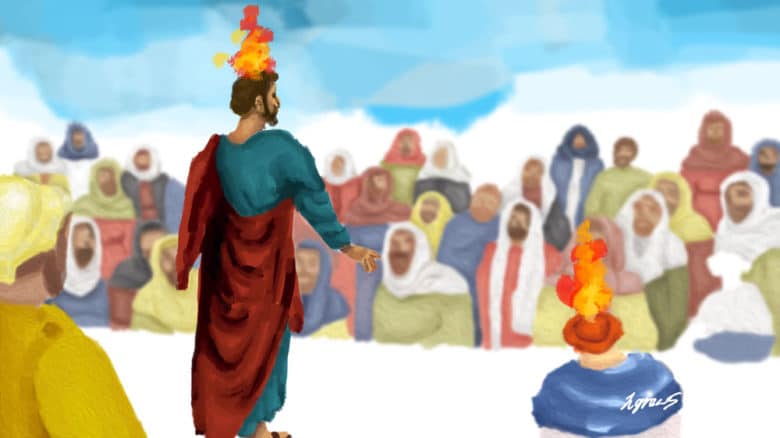A few months ago, we looked at the characteristics of Jesus’ Movement. The most important foundation of all we do in DMMs should be what Jesus taught and did, not Peter or Paul. After reflecting on Jesus’ ways of working, we can learn much from His disciples as well,
Let’s discover some basic characteristics of the Jerusalem movement, led by Peter and the earliest apostles. This movement began after Jesus rose again.
What did the Jerusalem Movement look like?
We’ll look at seven characteristics that affected the apostle’s fruitfulness. These reflect the idea that Peter and the apostles were disciples of Jesus, and followed what He taught and did. We should remember that teaching and practice were integrated. They should not be separated.
1. When the Kingdom of God was announced, wonders and signs followed.
Jesus gave the apostles power and authority over all demons and to cure diseases (Luke 9:1-2). These signs showed that the Kingdom of God was real, and helped many people believe.
In Acts we see that “many wonders and signs were done through the apostles” (Acts 2:43).
For example, Peter and John healed the lame man at the temple gate called Beautiful (Acts 3:1). Jesus had healed lame people at the temple before (Matt 21:14). Peter and John’s healing opened the door to proclaim Jesus (Acts 3:12-18). The result was that the number of believers increased to about 5,000 men, just like Jesus (Acts 4:4).
2. Growth of disciples through Peter and the Apostles
Let’s look at four important things about the growth of disciples.
A. Discipleship started with repentance and baptism
At Pentecost, when the people were cut to the heart and asked what they must do, Peter answered they should:
(i) Repent
AND
(ii) Be baptized in the name of Jesus Christ for the forgiveness of sins. Just saying “I repent” was not enough. They were baptized in water at the same time. (Acts 2:41).
There wasn’t a long time between repentance and baptism. This is what John the Baptist practiced. The people confessed their sins at baptism (Matt 3:6, Mark 1:4,5).
Like John, Jesus also proclaimed repentance (Mark 1:15). At first, Jesus himself was baptizing (John 3:22), and later His disciples were baptizing (John 4:1-2).
(iii) They would receive the gift of the promised Holy Spirit. Jesus had set the example of water and Spirit baptism coming together. From Pentecost onwards, those who believed were to receive the gift of the Holy Spirit also (Acts 2:38, 39).
We will look more closely at baptism in a future article. For now, it’s enough to highlight repentance and baptism in water and Spirit happened together for the new disciples after Pentecost.
B. Number of disciples grew quickly
Great numbers followed Jesus (Luke 6:17). The largest recorded number being 5,000 men (Luke 9:14). This rapid growth was also true for the Apostles. When Matthias was chosen to replace Judas, there were about 120 disciples (Acts 1:15). At Pentecost, they grew by about 3,000 (Acts 2:41). That same year their numbers grew to 5,000 men, not including the women and children (Acts 4:4). That is rapid growth of disciples!
C. Generational growth
In Acts, we observe the Jerusalem church (meaning the disciples who gathered in and around Jerusalem) growing generationally to regions beyond. Jerusalem was the first generation. Then, Philip, Peter, and John played important roles in making second-generation churches in Samaria and Judea (Acts 8:5-13; 8:25; 8:26-39). Antioch Syria was another second-generation church started by disciples from Jerusalem (Acts 11:19). From Antioch many third-generation churches were started by Barnabas and Paul.
D. “People of Peace”
As with Jesus, “People of Peace” played important roles in seeing the spread of the Gospel, Cornelius is an example (Acts 10:23-48).
3. The Movement spread widely
Through generational growth of churches, the Gospel spread far and wide. However, it wasn’t only Paul and his companions who did this. The Ethiopian Eunuch took the Gospel to Ethiopia. The Roman church was formed long before Paul got there, perhaps by visitors from Rome at Pentecost (Acts 2:10).
4. Focus on raising up leaders
As the Movement grew, the number and type of leaders also grew. Matthias was added to the eleven (Acts 1:15-26). Prophets such as Agabus arose (Acts 11:27). Philip was an evangelist (Acts 21:8). Elders, like James, brother of Jesus, were appointed (Acts 11:30; 12:17; 15:12-29).
Those who performed “acts of service” were appointed as deacons. Stephen and the seven oversaw the daily distribution for widows (Acts 6:1-6). They weren’t deacons serving the communion table. They led a compassion ministry in the church.
As the movement grew beyond Jerusalem, others such as Barnabas and Paul were appointed apostles (Acts 14:14). There were also prophets and teachers (Acts 13:1).
5. Persecution didn’t stop the Movement
Persecution came at different levels at different times. The martyrdom of Stephen led to great persecution, but the assembly continued to multiply (Acts 8:1; 9:31). The persecution by Herod, and the martyrdom of James, brother of John, did not stop the growth and multiplication either (Acts 12:1-5; 12:24).
6. The Apostles made disciples who made disciples
The Great Commission became a reality as the apostles made disciples who made disciples (Matt 28:18-20). The apostles discipled Barnabas, who discipled Saul, who discipled Timothy and so on.
7. The Apostles discipled in public places and in homes
Jesus discipled in public places (including synagogues and the Temple), and in homes. The apostles followed Jesus’ example and did not own a single place of worship of their own, nor did they desire one.
Their growth and multiplication were not tied to owning buildings. The disciples met and were taught in private homes (Acts 2:46; 5:42). In the Temple, they met at Solomon’s Portico in the Gentile court (Acts 3:11; 5:12). This was a common meeting place for Jewish Rabbis to teach their disciples.
The patterns that Jesus started, continued through the apostles and the Jerusalem church. This was the mark of raising up disciples of Jesus – they followed the teachings and practices of Jesus.
In a future article, we will look more closely at the daily activities of the Jerusalem church. They set the pattern for future assemblies (churches) in other places.
What Will You Do To Obey?
As you read, you likely noticed differences between your practices and those of the New Testament movements. What action will you take to see your disciple making efforts more like the model in the New Testament? Share in the comments below or on the Dmms Frontier Missions Facebook Group.



